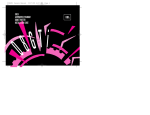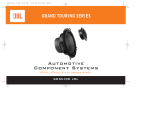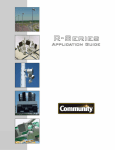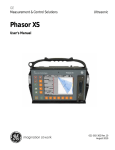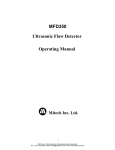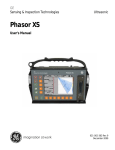Download JBL 404GTi Car Speaker
Transcript
404/504 MANUAL.QXP 7/17/98 11:39 AM Page 1 404/504 MANUAL.QXP 7/17/98 11:39 AM Page 2 Table of Contents Welcome to Club GTi ............................................3 About this Manual .................................................3 Autosound at its Best ............................................3 Designing Your System .........................................5 Coupled ComponentTM Placement.........................5 Installation Warnings and Tips ..............................6 Mounting Instructions ............................................6 Installing the GTi System Crossover .....................6 Woofer/Midrange Driver Mounting ........................7 Mounting Speakers in Custom Locations..............8 Wiring ..................................................................10 System Connections ...........................................10 Crossover Tweeter Level Adjustment..................12 Speaker Break-In ................................................12 A Note on Power Handling ..................................12 In Case of Difficulty .............................................13 Specifications ......................................................14 Thiele-Small Specifications .................................15 2 404/504 MANUAL.QXP 7/17/98 11:39 AM Page 3 Welcome to Club GTi About This Manual Autosound at its Best Thank you for purchasing the finest Automotive Coupled ComponentTM Systems JBL has ever produced. As a GTi Competition Series owner, you are a member of a select group of people who enjoy the most advanced mobile audio products available. We call this group “Club GTi.” By sending in the customer information card, which you will find attached to your warranty, we will automatically register you as a Club GTi member which will give you access to exclusive Club GTi apparel and other special offers we will make available from time to time. We suggest you fill the card out at your earliest convenience. Also, be sure to save your sales receipt in a safe place. It will be necessary to use this document as proof of purchase in the event that you ever need warranty service. It is also useful for insurance purposes and for establishing value when you re-sell your vehicle. Because of the performance capability of your GTi Competition Series product, and the variety of potential system configurations, we strongly recommend that you have the system professionally installed. You will also get a better warranty if your equipment is professionally installed by an authorized GTi dealer and you have your warranty card stamped. This manual provides information on installation and usage to help a skilled technician get the most from your GTi Competition Series product. This manual does not cover basic information about installation which is common knowledge to a professional installer, except for information which is unique to the 404 and 504GTi systems. If you feel you possess the necessary skills, and prefer to install the equipment yourself, this manual will provide you with the necessary specifics to properly use the 404 or 504GTi in typical installations. Consult your JBL dealer, or a qualified technician, for more information. The 404 and 504GTi Coupled ComponentsTM are built to meet the same rigorous standards of construction and performance that have long established JBL’s renowned home and professional speaker systems. Coupled ComponentsTM are the first to provide true component driver quality in a format which mounts in a single hole. The GTi Coupled ComponentsTM combine the reference standard 400 and 500GTi Woofer/Midrange Drivers with a cantilever mounted 20mm Pure Titanium tweeter and outboard 2-way crossover. The tweeter is mounted at a 15° angle which, combined with the exclusive IntermountTM mounting system, allows orientation of the speaker for optimum imaging in any vehicle. The near-coincident mounting provides the considerable advantages of equal soundpath length from the woofer and tweeter to your ear, but without the horn loading effects that create a distorted midrange in designs with apex-mounted tweeters. 3 404/504 MANUAL.QXP 7/17/98 11:39 AM Page 4 The 404 and 504GTi Woofer/Midrange Drivers incorporate advanced JBL woven Kevlar cones which are especially suited to the unique acoustic and environmental conditions which characterize automotive sound. The 20mm tweeter incorporates advanced JBL pure titanium technology which works extremely well in the unique acoustic environment of modern vehicles. The 404 and 504GTi have been engineered to provide excellent power handling, good dispersion and balanced frequency response, along with minimum size and flexible installation options for optimizing placement within the vehicle. Treated Kevlar fiber cones are used because of their combination of low weight, high stiffness and resistance to resonances. The 404 and 504GTi Woofer/Midranges are topped off with a treated fabric inverted dome for smooth reproduction of upper midrange frequencies. The cone motion of these high excursion woofer/midrange designs is controlled by a Aromatic Polyamid fiber spider. Because it is 3 times stronger than 4 conventional spider materials, this robust material is able to control the up to 0.6" motion of the cone while maintaining musical accuracy. The small size of the GTi Woofer/ Midrange Drivers is made possible through the use of a Neodymium magnet assembly with JBL’s Stray Field Containment Geometry. By minimizing stray magnetic fields, this closed circuit magnetic assembly design concentrates the magnetic field on the voice coil where it provides superior performance. In the woofer/midrange drivers, this high concentration of magnetic power is coupled to a 2" Edge-wound Aluminum Wire High Temperature Fiberglass Voice Coil. This coil uses lightweight aluminum wire to maintain the agility to reproduce high frequencies while its large diameter and fiberglass former assures extremely high thermal power handling. The tweeter uses Oxygen Free Copper wire immersed in a thermally conductive bath of viscous FerrofluidTM. This fluid not only conducts heat away from the voice-coil to improve power handling, but damps the fundamental resonance of the dome for optimum sound. The tweeters in the 404 and 504GTi feature domes made from pure titanium. Pure titanium has long been known to have a very high stiffness to weight ratio, making it ideal for treble reproduction. However, only JBL has “tamed” titanium through a special manufacturing process. The dome of the 404 and 504GTi Tweeter is created using special nitrogen gas cooled forming machines which can create a uniformly paper-thin dome without the work-hardening or deformation which causes resonances in domes made without benefit of this process. Equally important is the 404 and 504GTi crossover design. Each crossover was meticulously optimized in JBL’s stateof-the-art acoustic laboratory to guarantee a seamless blend of the woofer/midrange and tweeter output. Unlike generic or general purpose crossovers, the design of the 404 and 504GTi Crossovers was performed with a full knowledge of the performance characteristics of each driver, allowing frequency, phase, and power 404/504 MANUAL.QXP 7/17/98 11:39 AM Page 5 response to be completely optimized for each combination. What does all this technology add up to? A Coupled ComponentTM system with ideal frequency balance, excellent off axis response, and high output capability in a small, elegant package. The result is exceptionally smooth and detailed music reproduction over the full range of frequencies and clean sound that cuts through road noise. These Coupled ComponentsTM can be placed in stock locations yet still deliver the punch and performance of a component system. The near-coincident, low profile tweeter mounting and small size of the driver allow these Coupled ComponentTM systems to be mounted for optimum imaging in ways that cannot easily be achieved with separate component systems. Designing Your System The overall quality of any system design is a result of how well all of the components work together, not just the result of the performance of any one component. JBL GTi Series woofer/ midbass or subwoofer transducers are the ideal companion products to your 404 and 504GTi systems. Each of the GTi Competition Series products are designed to complement the others to provide the highest performance with the simplest and most predictable system design. To use the 404 and 504GTi as the satellite transducers in a high quality system, we recommend you use either a high quality active crossover such as JBL’s GTX47, GTX4 or GTX2 to provide optimum matching to your subwoofer or woofer/midbass loudspeaker. If you prefer passive crossovers, we recommend that you use only high quality audiophile grade film-type capacitors and Low DCR inductors to get the most out of your system. The most popular system configuration is a hybrid using an active crossover for the subwoofer to woofer/ midrange crossover point, and the passive crossover included with your Coupled ComponentsTM for the woofer/midrange to tweeter crossover. Your GTi Competition Series dealer is uniquely qualified to help guide you on the best system configuration for your needs. Coupled Component TM Placement The location of each of the loudspeakers plays a vital role in achieving proper frequency response and spacious imaging. The near-coincident design of the Coupled ComponentsTM gives the 404 and 504GTi systems an extremely wide and smooth dispersion pattern. As a direct result, excellent performance may be achieved in any vehicle. Due to the wide variety of vehicles, there is more than one “right” way to locate the 404 and 504GTi. Knowledge of the following considerations will help you get the most from your system: 5 404/504 MANUAL.QXP 1. 2. 3. 4. 7/17/98 11:39 AM Page 6 The most spacious stereo image is achieved when the speakers are placed as wide apart as possible. The best center image will be achieved when the distance from the left speaker to your left ear is as equal as possible to the distance from the right speaker to your right ear. This is most easily achieved by placing the 404 and 504GTi as far forward as you can. You will get the best frequency response when the path from the speakers to your ear is unobstructed. Because of the high acoustic energy capability of the 404 and 504GTi, they must be securely mounted in a rigid panel which is free from resonances, rattles and air leakage. Installation Warnings and Tips Mounting Instructions • Pick a mounting location after reading the recommendations in the Coupled Component™ Placement section of this manual. • • • • 6 Be careful not to cut or drill into fuel tanks, fuel lines, brake or hydraulic lines, vacuum lines or electrical wiring when working on your vehicle. When door mounting the speakers, make sure there is sufficient clearance for windows, electric window motors or cranks, and linkages. Inspect behind panels before you cut or drill. Be sure to check for clearance of window, cranks and linkages when mounting speakers in door panels. Do not use the speakers unmounted. Failure to securely mount this product could result in damage or injury, particularly in the event of an accident. Although the materials used on the 404 and 504GTi are inherently water resistant, do not mount the speakers where they will get wet. Always disconnect the ground wire from the battery before doing any work on the vehicle. Installing the GTi System Crossover The GTi system crossover should be mounted securely to prevent damage to the crossover or possible loosening of wiring connections. Choose one of the crossover mounting methods and follow the directions on the following page. 404/504 MANUAL.QXP 7/17/98 11:39 AM Page 7 Mounting the GTi Crossover with Wire Ties 1. Remove the crossover cover as shown in Figure G. 2. Remove the crossover board from the plastic case. 3. Use wire ties to secure the plastic case to the desired location as shown in Figure A. 4. Cut off the excess plastic on the wire ties. 5. Re-install the PCB and install wiring from the crossover to the amplifier and speaker locations as shown in Figure F. 6. Re-install the crossover cover. Mounting the Crossover with Screws 1. Remove the crossover cover as shown in Figure G. 2. Remove the crossover board from the plastic case. 3. Mark 4 hole locations, drill holes and secure the bottom cover to the desired mounting location as shown in Figure B. Before starting, make sure no electrical or other critical car components are located where you will be drillling. 4. Re-install PCB and install wiring from the crossover to the amplifier and speaker locations as shown in Figure F. 5. Re-install the crossover cover. Figure A Figure B Woofer/Midrange Driver Mounting Mounting to Stock Hole Locations 1. Access the stock speaker location and remove the stock speaker. The 404 and 504GTi include IntermountTM mounting ring adapters which allow the speaker to be mounted in standard 4" and 51/4" holes respectively. 2. Mount the intermount adapter plate to the stock location using four #8 x 11/4" screws as shown in Figure C. 3. Attach the foam gasket to the back of the woofer/midrange. Connect the speaker wire from the crossover terminals marked “W” to the woofer/midrange terminals of the speaker by either soldering (preferred) or using crimp terminals. Connect the “+W” terminal of the crossover to the orange “W” terminal of the speaker. Repeat for “–W” terminal. 7 404/504 MANUAL.QXP 4. 5. 6. 7/17/98 11:39 AM Page 8 Connect the speaker wire from the crossover terminals marked “T” to the tweeter terminals of the speaker by either soldering (preferred) or using crimp terminals. The “+T” terminal of the crossover should be connected to the orange colored T terminal on the speaker. The IntermountTM adapter plate has a series of mounting holes which allow the coupled component tweeter to be angled as desired. Pick an orientation which angles the tweeter in the desired direction and mount the woofer/midrange driver to the IntermountTM adapter ring using three #8 x 7/16" screws as shown in Figure C. Replace the stock speaker panels. INTERMOUNT ADAPTOR PLATE Mounting Speakers in Custom Locations 1. Figure C 2. 3. 4. 8 Snap the grill of the speaker onto the driver and choose three hole locations so that the tweeter is angled properly and the grille logo is oriented as desired for your installation. Use the Fabric Displacement Ring included in the package to mark the location of the three screw holes and the speaker cutout holes (cutout hole sizes are listed in Specifications section). Before cutting or drilling make sure that there are no car components, electrical wiring or any other items that could be damaged. Cut out the speaker hole at the mounting location and drill the three marked pilot holes with a 1/8" (3mm) drill. Run speaker wire to the hole location, making sure that either an active or the included passive crossover is connected before the speaker. Put the speaker Fabric Displacement Ring under the speaker as shown in Figure D. 404/504 MANUAL.QXP 5. 6. 7. 8. 7/17/98 11:39 AM Page 9 Connect the speaker wire from the crossover terminals marked “W” to the woofer/midrange terminals of the speaker by either soldering (preferred) or using crimp terminals. Connect the “+W” terminal of the crossover to the orange “W” terminal of the speaker. Repeat for “–W” terminal. Attach the foam gasket to the back of the woofer/midrange. Connect the speaker wire from the crossover terminals marked “ T ” to the tweeter terminals of the speaker by either soldering (preferred) or using crimp terminals. The “+T” terminal of the crossover should be connected to the orange colored T terminal on the speaker. Mount the speaker to the hole location using three #8 x 11/4" screws as shown in Figure D. Push the grille down onto the speaker, making sure the tabs on the speaker, match with the slots in the grille. Twist the grille about 1/2" (12mm) clockwise to lock the grille into place. GRILLE FRAME FABRIC DISPLACEMENT RING Tab slot Figure D METAL GRILLE Figure E TAB Note: The metal grille is designed so that it can be covered with grille cloth if desired. Simply, remove the metal grille from the plastic trim ring as shown in Figure E. Then use spray adhesive to glue and wrap the grille cloth to the metal grille. Push the metal grille with cloth back into the grille frame. For even better interior matching it is also possible to use plastic compatible paint to match the grille frame to the vehicle’s interior. Logo Orientation on Grille The orientation of the logo on the grille relative to the plastic grille ring can be adjusted. Simply remove the metal grille and reassemble the metal grille to the grille frame utilizing a different tab slot. 9 404/504 MANUAL.QXP 7/17/98 11:39 AM Page 10 Wiring Use 2-conductor stranded type, insulated wire to connect the 404 and 504GTi Woofer/Midrange and Tweeter to the included crossover, and the crossover to the amplifier as shown in Figure F. A minimum wire gauge of 18AWG is recommended, with larger size suggested for wire runs longer than 10 feet. TWEETER WOOFER INPUT TWEETER WOOFER INPUT Figure F 10 504 GTI Crossover The polarity (the positive / negative orientation of the connections) for every speaker and crossover to amplifier connection must be consistent from left to right channel to assure proper imaging and optimum frequency response. This does not mean that the Coupled ComponentsTM should always be connected in the same polarity as the woofer/midbass or subwoofer however. It is possible, due to the difference in the distance that the sound travels from the Coupled Components™ to your ears, compared to the distance from the subwoofer or woofer/midbass, and the wavelengths of sound at the crossover frequency, that a connection where the subwoofer or woofer/midbass are connected in reverse polarity from the Coupled ComponentTM drivers may actually result in better sound. Because there is no way to accurately predict this before installation, we recommend that you try the connection both ways, and leave it in the polarity that gives the smoothest audible transition between the Coupled Components™ and the subwoofer or woofer/midbass. Some active crossovers, such as the JBL GTX47, have a phase switch which enables you to easily switch polarity. When the subwoofer or woofer/midbass and Coupled ComponentsTM are mounted close to each other, the in-phase connection will usually yield the best sound. System Connections There are a variety of system options available with the 404 and 504GTi. The simplest configuration is to use the 404 and 504GTi full range. Although this will yield good sound, the best performance will be achieved in a high-end system which includes subwoofers and, optionally, midbass transducers. Because the 404 and 504GTi are specifically designed for mid and high frequency operation, they should have their extremely low frequencies blocked by electrical means in order to achieve the best system fidelity and the widest dynamic range. However, full range use may be obtained at slightly lower power handling levels. 404/504 MANUAL.QXP 7/17/98 11:39 AM Page 11 For the best performance, we recommend that an active crossover with a minimum of 12dB per octave slope be used for the transition point between the Subwoofer and the 404 or 504GTi. The optimum crossover frequency for this transition is dependent on the specific components used, the vehicle, and other installation details. As a general rule, the crossover frequency should be as low as possible to achieve the best system imaging. You can fine-tune the crossover after the installation is complete for the best sound. A good place to start your tuning process is between 50Hz and 150Hz when using the 504GTi and between 80Hz and 150Hz when using the 404GTi. In 4-way systems using a midbass driver such as the 600GTi, the crossover point may be raised higher without detrimentally affecting imaging as long as the woofer/midbass drivers can be mounted reasonably close to the Coupled ComponentsTM. This higher crossover frequency will allow the system to play louder. Since no crossover is perfect, it is advisable to keep your crossover points away from the range where your hearing is most sensitive. Therefore we recommend that you try to keep the high-pass frequency below 250Hz. This lets the 404 or 504GTi reproduce the entire range of frequencies covering the most important vocal and lead instrument fundamentals and their harmonics. If you prefer to use all passive crossovers, you will need to construct or purchase a high-pass filter for the subwoofer to Coupled ComponentTM transition point and install it in-line ahead of the 404 or 504GTi Crossover. For the best system dynamic range, we recommend that a minimum slope of 12dB per octave be used. The most advanced system designs use active electronic crossovers such as the JBL GTX2, GTX4 or GTX47 at both the subwoofer (or woofer/midbass)-to-Coupled Component™ transition point and at the woofer/midrange-to-tweeter transition. This is possible with the coupled component system because the tweeter and woofer/midrange are accessible separately through the individual sets of terminals. Set the high crossover frequency at or above 5kHz if a 12dB per octave crossover is used and at or above 4.5kHz if you are using an 18 or 24dB per octave crossover. In this configuration, the crossovers supplied with the 404 and 504GTi are not used. For tweeter protection, a 1.5A fast acting fuse should be installed in series with the tweeter. The maximum recommended RMS amplifier power routed directly to the woofer/midbass driver is 125 watts for the 404GTi and 150 watts for the 504GTi. When used with the appropriate crossover and fused as recommended above, the tweeter can be connected to amplifier channels of the same power rating although there is little point in using an amplifier in excess of 50 watts when driving the tweeter alone. 11 404/504 MANUAL.QXP 7/17/98 11:39 AM Page 12 Crossover Tweeter Level Adjustment The GTi system crossover allows you to adjust the level of the GTi systems tweeter. This adjustment is located under the crossover cover. To remove this cover simply press on the end of the cover (as shown in Figure G) and lift off. The adjustment of the tweeter level is done by setting the switch on the crossover (see Figure H) to the “0dB”, “–2dB” or “–4dB” position. Set this switch in the position that matches you personal preference. Both crossovers should have this switch set in the same position. LIFT PRESS Figure G OdB –2dB –4dB Figure H Speaker Break-In The 404 and 504GTi woofer/ midranges use many high strength materials which require benefit from a break-in period before they will achieve top performance. After a break-in period of about 1-hour at moderate volume the drivers will achieve peak performance. 12 A Note on Power Handling As a result of their high efficiency, all JBL loudspeakers will produce reasonable volume levels in the automotive environment using very little amplifier power. However, the use of a low-powered amplifier to attain very high volume levels could lead to overdriving the amplifier. This will generate high distortion levels which can easily damage loudspeakers, even if the rated power of the amplifier is below the rated maximum power handling of the loudspeaker! As a general rule, do not turn up the volume control past the point where you hear distortion in the form of either signal distortion from an overdriven amplifier or mechanical noise from an overstressed speaker. For the best performance and system reliability, you should select an amplifier with an output rating greater than the maximum power likely to be used to generate the desired volume levels. If you want your system “Loud + Clear,” we suggest that you step up to a JBL power amplifier which has an RMS power rating equal to, but not exceeding, the Maximum Recommended Amplifier Power listed in the specifications of your specific JBL speaker. This margin of reserve power will ensure that the amplifier will not attempt to deliver more power than its design allows. Your dealer will be happy to point out which high power JBL amplifiers are 404/504 MANUAL.QXP 7/17/98 11:39 AM Page 13 optimum for your application and listening habits. Following these guidelines will provide virtually distortion free sound reproduction and long loudspeaker life. In Case of Difficulty The most common difficulties are noise, distortion, and intermittent connections. System noise is usually not the fault of the 404 or 504GTi. Hiss or “alternator whine” is most often the result of faulty grounding of the system electronics or improper setting of amplifier level controls. An exception to this is if the passive crossover networks are mounted near a source of radiated noise, the network may pick-up this noise with sufficient power to drive the 404 and 504GTi. For this reason, be careful not to mount any passive crossovers near wires carrying high currents such as battery cables or wires leading to ammeters or tachometers. Distortion is usually the result of overdriving one or more components in the system. The problem is most likely insufficient amplifier power, or improper setting of gain controls. Refer to the instructions which came with the electronics for assistance. The 404 and 504GTi will not play as loudly, or handle the full rated power, when used without a subwoofer and associated high-pass crossover. When using the 404 or 504GTi full-range, be careful to limit the volume level to that which can be reproduced without audible distortion from the speaker. If you want to talk to us about any problems, call JBL Customer Service at 1-800-336-4JBL (4525) between 9AM and 5PM eastern time. 13 404/504 MANUAL.QXP 7/17/98 11:39 AM Page 14 Specifications: 404GTi 504GTi Frequency response: 80 – 21kHz 60 – 21kHz Recommended minimum High-Pass Crossover Frequency for High Power Operation: 80Hz 50Hz Continuous Power Handling With 12dB Passive Network High Passed at Recommended Minimum Frequency: 85 Watts 120 Watts Continuous Power Handling When Used Without High-Pass (Full-Range Operation): 60 Watts 80 Watts Minimum Recommended Amplifier Power: 20 Watts 20 Watts Maximum Recommended Amplifier Power Rating: 125 Watts 150 Watts Sensitivity (2.83 Volts / 1 Meter): 89dB 91dB Impedance: 4 Ohms 4 Ohms 43/8" (111mm) 51⁄8" (130mm) Dimensions – Woofer/Midrange Transducers Overall Maximum Diameter (Mounting Tab to Frame Edge): Height: Mounting Depth: 18 23⁄8" (60mm) 78 21⁄16" (53mm) 34 2 ⁄ " (54mm) 1 ⁄ " (48mm) Cutout Size: 3 ⁄ " (95mm) 43⁄4" (121mm) Weight (1 Driver): 1 lb. 9 oz. (0.71kg) 1 lb. 13 oz. (0.82kg) Dimensions – Tweeter Overall Diameter: 115⁄16" (50mm) 115⁄16" (50mm) Height: 11 11 Height With Angle Adapter: 11⁄2" (38mm) 11⁄2" (38mm) ⁄16" (18mm) ⁄16" (18mm) Flush Mount Cutout Diameter: 21⁄8" (54mm) 21⁄8" (54mm) Flush Mount Depth: 15 15 Dimensions – Crossover Network (LxWxH): 5 10/16" x 3 3/16" x1 9/16" 5 10/16" x 3 3/16" x 1 9/16" (143mm x 81mm x 40mm) (143mm x 81mm x 40mm) 14 ⁄16" (23mm) ⁄16" (23mm) 404/504 MANUAL.QXP 7/17/98 11:39 AM Page 15 Thiele-Small Specifications: 404GTi 504GTi Free Air Resonance (Fs): 125Hz 100Hz Electrical Damping (Qes): 0.52 0.51 Mechanical Damping (Qms): 5.17 5.14 Total Damping (Qt): 0.47 0.4 Equivalent Volume of Compilance (Vas): 0.0388 cu. ft. (1.10 liters) 0.1059 cu. ft. (3.0 liters) Effective Cone Area (Sd): 9.3 sq. inches (0.0060 m2) 14.26 sq. inches (0.0092 m2) Center to Peak Linear Excursion (Xmax): 0.126 inches (3.2mm) 0.126 inches (3.2mm) Voice Coil DC Resistance (Re): 3.4 ohms 3.4 ohms Voice Coil Inductance (Le): 0.22mH @ 1kHz 0.22mH @ 1 kHz Voice Coil Diameter: 2 inches (51mm) 2 inches (51mm) Voice Coil Length (Winding Length): 0.400 inches (10.2mm) 0.400 inches (10.2mm) Air Gap Height: 0.200 inches (5.1mm) 0.200 inches (5.1mm) BL Product: 6.2 T/M 6.2 T/M Effective Moving Mass (Mm): 0.28 oz. (8.0 Grams) 0.32 oz. (9.0 Grams) Note: Specifications apply only after a 2 hour break-in period at medium volume levels. JBL continually strives to impove its products. New materials, production methods and other refinements may result in a change from published specifications and description. The changes will equal or exceed the original specifications, unless otherwise stated. 15 404/504 MANUAL.QXP 7/17/98 11:39 AM Page B A Harman International Company NMGP/N:304353-001 5/94



















